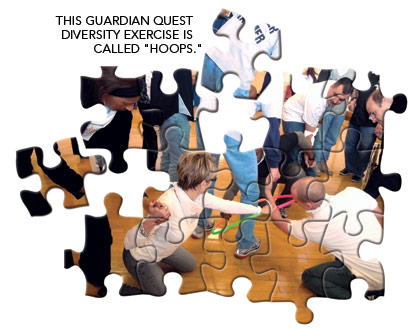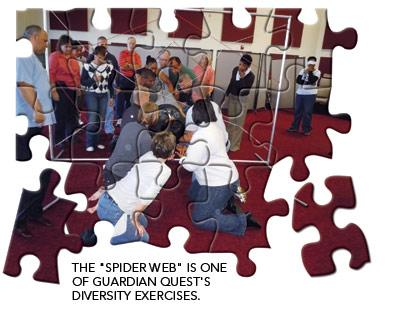By Todd Henneman
Workforce.comLecturing employees about diversity is one thing, but some companies are taking training a step further. Strategies include engaging employees in teamwork exercises and having workers simulate disabilities.
In July, Jennifer Vena decided to talk with colleagues about Tourette’s syndrome after watching video clips of American Idol contestant James Durbin and public speaker Marc Elliot, both of whom have the neurological disorder known for causing motor and vocal tics.

It’s the latest in a string of topics advanced by Vena since she decided a year ago to add one item about diversity to her team’s monthly meeting agenda. “It is really each individual making a commitment to demonstrate inclusiveness in his or her daily actions that will make a difference,” says Vena, a senior consultant at Bright Horizons Family Solutions, a private company that manages employer-provided child care centers.
Vena’s self-imposed monthly commitment is part of an initiative known as One Thing introduced last year by Bright Horizons. The brainchild of the company’s diversity council, One Thing challenges employees to take one action that fosters workplace diversity and inclusion. More than 600 employees have submitted One Thing commitments. Other employees have vowed to take new co-workers to lunch so they feel welcomed or to read books to learn about other dimensions of diversity.
“It’s an evolution of the way we’re doing the work,” says Dan Henry, Bright Horizons’ chief human resources officer and co-chair of the diversity council. “There is only so much training you can do in this space. At some point, it has to come down to what people do.”

Bright Horizons isn’t the only company whose diversity practices are evolving. Increasingly, companies are supplementing lectures with activities ranging from simulating deafness to using case studies that hone skills for navigating complex situations. The goal: to create better managers, not simply more sensitive ones.
“Companies are offering courses on how to be an effective team member, conflict resolution, cultural agility,” says Quinetta Roberson, a management professor at Villanova University’s School of Business who has researched diversity trends. “They’re giving people an openness to experience where people can deal in various contexts with various people, where people have the tools to navigate in any context.”
Beyond guilt trips

The National Training Laboratories of Bethel, Maine, which is now called the NTL Institute, determined more than a decade ago that “practice by doing” is second only to “teaching others” as the most effective way of learning. But only in recent years has diversity training transitioned away from side shows and guilt trips to skill-building, such as resolving conflict and providing developmental feedback to subordinates with whom managers have little in common.
“People learn more by doing,” says Ondra Berry, co-founder of training firm Guardian Quest. “We can recite experiences from our lives blow-by-blow because we remember more when we’re actively involved, especially when it has made an impact on us.” NV Energy Inc., which provides electricity to 2.4 million customers throughout Nevada, hired Guardian Quest for three days of training four times per year.
The sessions are about teamwork as much as they are about diversity. In one, a line of people must navigate under chairs and around other obstacles, communicating only through taps and touches. In another, the group must figure out how to pass everyone through a spider web of ropes.
Carolyne Sharp attended the training after changing jobs involuntarily as part of a reorganization at NV Energy. She was unhappy because she had been transferred from a power plant, where she liked her co-workers, to the corporate office, where she would be working in purchasing and contracts.
“After I took the training, I was fired up,” Sharp says. “I found my voice. I wasn’t afraid to say something anymore. The true me came out again.”
Since, she has won five awards for her efforts to expand the number of minority suppliers, holds regular reunions for her training cohorts and organizes an annual companywide event to honor veterans.
The earliest forms of diversity education arose soon after President John F. Kennedy signed an executive order in 1961 that required federal contractors to “take affirmative action” to avert discrimination based on race or national origin. By 1963, government contractors such as Western Electric provided two days of lectures and discussions about prejudice to leaders of all their locations.
During the 1970s when the U.S. Equal Employment Opportunity Commission gained the power to bring lawsuits against private companies, training sessions proliferated to help employers avoid litigation. These compliance sessions evolved in the 1990s into training that used broader definitions of diversity, including factors such as sexual orientation, religion, communication styles and tenure.
Now, companies are increasingly looking for quantifiable returns on their investment. They’re tracking employee engagement to see whether the training translates into higher scores and looking at 360-degree evaluations to see whether managers gained skills.
“The expectation is more than a good experience,” says Michael Hyter, president of diversity consultant Global Novations. “It’s real, measurable learning. It’s a measurable outcome. There is a specific skill that ought to be obvious for the investment that we’re making in this person’s development experience.”
Hyter says that he holds his firm to a different standard than he did a decade ago, emphasizing to clients how his firm’s training builds competencies and enhances employee engagement.
In one instance, a client had become alarmed about turnover among women of color. Hyter’s firm conducted a cultural audit, which suggested managers were weak at providing developmental feedback across the board, not only to women of color. The firm identified competencies, trained managers and embedded behavior into 360-degree evaluations every 90 days. Within 18 months, turnover decreased and more women and minorities had risen within the organization.
“If we talked 10 years ago, I would have said we gave 5,000 people diversity training and left, and they loved it,” Hyter says. “But nothing much would have changed. There was no real measurable change in behavior or skills.” Nowadays, he asks specifically what outcome clients seek and looks at what skills drive those results.
In 2010, 68 percent of the member organizations surveyed by the Society for Human Resource Management indicated that they have practices in place to address workplace diversity compared with 76 percent of organizations surveyed in 2005. But of companies with diversity practices, 71 percent say they provide training compared with 67 percent in 2005.
“The organizations that were really invested in diversity and inclusion work before the recession hit remain so,” says Eric Peterson, SHRM’s manager of diversity and inclusion. “Those who were getting started, it was an easy cut to make when they needed to cut back.”
Making an investment
Sodexo Inc. is among the companies that have invested years of time and money into diversity strategy. The food and facilities-management services company offers multiple diversity workshops available to everyone from cashiers to members of the C-suite, invites outside speakers to lead sessions at its annual diversity conference and offers webinars available anytime from any location.
“We use every opportunity we can to spark people’s interest and seed a desire to learn more,” says Betsy Silva Hernandez, Sodexo’s senior director of diversity, learning and consulting.
Managers attend a full-day diversity workshop, facilitated by a cohort of external trainers, within six month of joining the company. There, managers learn about their role in building an inclusive workplace, reflect on their own views of diversity and explore situations that they may encounter. One scenario presents a white male voicing resentment based on his perception of reverse discrimination.
“It gives them an opportunity to talk about the issues in a safe place—what they feel are going to be their challenges—and an opportunity to talk about what they can better do to lead in this space,” Hernandez says.
Managers can opt to attend 15 Diversity Learning Labs, follow-up sessions that range from 90 minutes to three hours offered throughout the year. Topics include gender, sexual orientation, cross-cultural communication and disabilities. A recent lab simulated working with disabilities. For one hour, participants lived with a disability. One employee wore special earplugs that blocked all sound, another temporarily lost vision, while someone else spent time in a wheelchair.
“We want it to be interactive,” Hernandez says. “We look at 90 percent interaction and 10 percent sharing information and raising awareness.”
John Friedman, director of public relations for Sodexo, gave up his sense of hearing during the lab. He went with a colleague to a place that was “100 percent familiar, where we’d been to 100 times in our own building,” he says. “It was a markedly different experience and profoundly humbling.”
Eight years ago, Sodexo also began conducting an annual diversity and business summit, a place where it tests new learning labs on such topics as generational differences. Each year, the full-day event is held in a different region, with area managers invited to attend with North American president and CEO George Chavel and his executive team.
As diversity has become ingrained into business strategies, Chavel and other chief executives are immersing themselves in their companies’ initiatives. Their involvement underscores the organizational commitment to diversity.
Consider, for example, Mark Wagar, president and CEO of Empire Blue Cross and Blue Shield, the New York City-based subsidiary of WellPoint Inc. In 2008, the company introduced the Empire Diversity Council to serve as an advisory body to its senior-management team. Wagar then launched a “community ambassador program” in which members of employee resource groups help identify ways of better serving their own demographic.
When Asian employees formed a resource group last year, they asked Wagar to serve as executive sponsor because, he says, “of my activism.” A self-described “giant Dutchman,” Wagar agreed and is working with members on a business plan detailing employee education and customer research goals.
“If it’s a business reality that there’s lots of old white men running companies, if you don’t have old white men who are willing to speak out about this and about how it [diversity] makes richer lives and better business,” Wagar says, “it’s not going to go as fast as it otherwise would.”
Some companies also are linking diversity education to performance evaluations. Bright Horizons evaluates employees against the company’s values, known as the Heart Principles. Employees learn about this connection in diversity training they attend during their first 90 days. Among those principles: “We strengthen our organization by embracing diversity and never allowing acts of nonacceptance.”
Sodexo goes further. It ties managers’ bonuses to training, recruitment and other diversity goals. This connection provides an incentive for managers to attend additional training sessions and to encourage subordinates to do so, as well. The strategy appears to be working: In fiscal 2009, 2,900 employees participated in 85 learning labs, and the next year 6,900 attended 243 labs. Through June, Sodexo already had exceeded its 2010 attendance.
Discussions about business cases for diversity—reducing turnover-related expenses, tapping new market niches, better understanding customers—still dominate conferences.
But Caesars Entertainment Corp. is taking a novel approach. Fred Keeton, chief diversity officer of the casino operator based in Las Vegas, has developed a concept that he calls “Diverse by Design.” Many organizations assume that having a diverse workforce naturally creates better teams, but Keeton handpicks team members to ensure that the teams have what he considers to be the relevant mix.
He applies the hospitality industry’s concept of yield management to diversity, creating teams with what he considers the best mix of cognitive styles and experiences to solve thorny business problems or drive revenue.
“Every dimension is not always important to what you want to do,” says Keeton who is also vice president of finance for external affairs. “You’ve got to manage your diversity like you manage so many other things.”
He mines employee data, picking the most relevant attributes using a matrix that considers everything from thinking styles to job function, geography, cultural style and the traits traditionally thought of as diversity: race, gender or ethnicity.
Insight into cognitive styles, for example, comes from the Herrmann Brain Dominance Instrument survey, collected and shared with employees in diversity training conducted during their first 90 days.
Caesars uses Diverse by Design teams for only its toughest tasks. “If you have a problem that’s a really easy problem, having a lot of diversity doesn’t necessarily help you answer that problem,” Keeton says. “If you’ve got a really hairy, nasty, dirty problem that’s hard to solve, diversity becomes most potent. We call it creating the capacity to call the baby ugly because the people who created the baby aren’t going to call it ugly.”
The company piloted the first two teams in 2009 and has since formed eight other teams. One looked at ways of improving buffets. The team didn’t review the food itself, but rather proposed ways to increase the efficiency and effectiveness of buffet operations. A second team looked at the revenue-management systems of hotels, while another focused on whether to buy new or retain existing slot machines and what mix of games to offer.
Keeton says the results are proprietary information but the strategy is working.
Yet even after 50 years, diversity programs continue to spark debate. Sociologist Frederick Lynch, an associate professor of government at Claremont McKenna College in California, argues that diversity programs promote the notion of hiring people because of their skin color, gender or other demographic traits. He considers this tokenism.
“As I see it, we have gone from trying to make up for past discrimination to affirmative discriminations,” says Lynch, author of The Diversity Machine: The Drive to Change the “White Male Workplace.” Changing demographics may lead to a “natural affirmative action,” he says.
But other experts believe diversity won’t just happen without a lot of hard work. Patti Digh, a former vice president of international and diversity programs for SHRM and co-founder of the training firm the Circle Project, voices her frustration that companies insist on developing business cases before advancing diversity, saying this demand amounts to a stalling tactic. Diversity programs no longer need to be justified, Digh says.
They’re core business tools that should be integrated across product development, marketing and communication, not thought of as a separate silo.
“In the year 2011, continuing to say, ‘We have to build a business case for diversity’ is like saying, ‘We should really look into this new Internet fad,’ ” Digh says.






